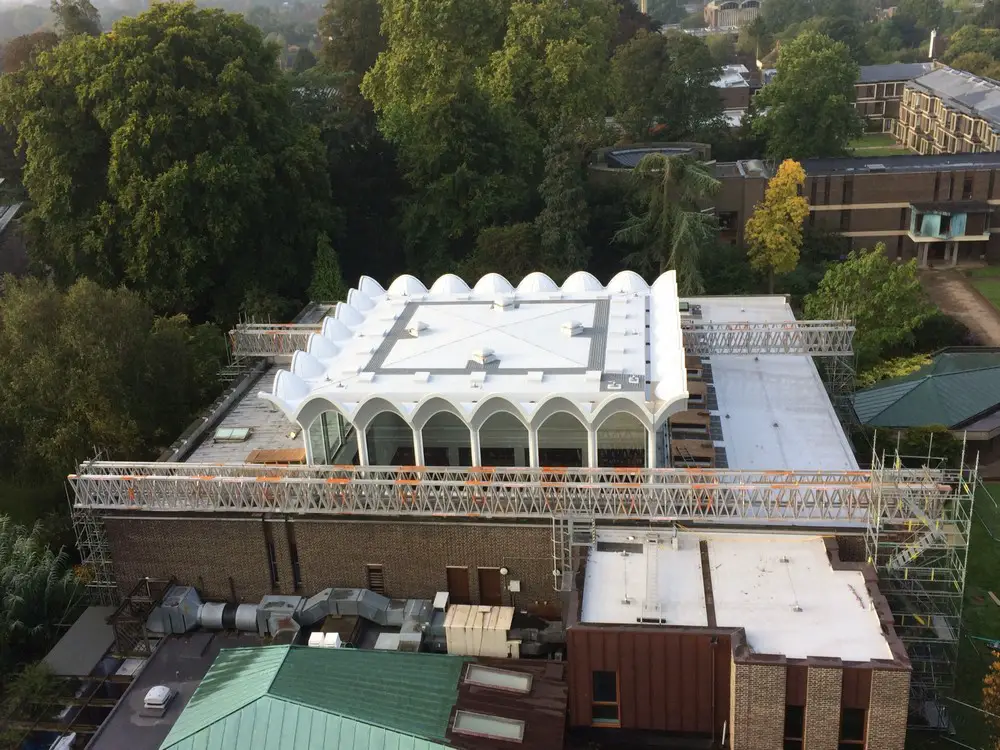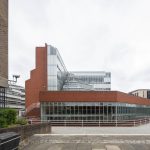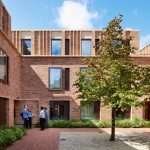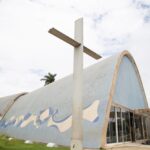Fitzwilliam College Cambridge, Architecture, Lasdun Building Photos, Renewal Design, Architect
Fitzwilliam College Cambridge
Cambridge University, England, UK – reneweal by architects Cullinan Studio
Fitzwilliam College Building
Original Design: Sir Denys Lasdun Architect ; Architects: Cullinan Studio
Fitzwilliam College Building Roof
ICONIC BRUTALIST GEM PRESERVED WITH INNOVATIVE
SIKA SARNAFIL ROOF SOLUTION
The roof refurbishment of the Central Building at Cambridge University’s Fitzwilliam College is one of the first major projects to use a new, pioneering approach combining Sika Sarnafil’s single ply membrane with large areas of its Sikalastic 621 – a liquid applied product typically used for areas with complex detailing.
This pairing of systems was further enhanced by Sika Refurbishment’s SikaFloor 420, providing a complete building envelope solution.
Fitzwilliam College in Cambridge has a newly refurbished roof thanks to an innovative Sika Sarnafil solution:
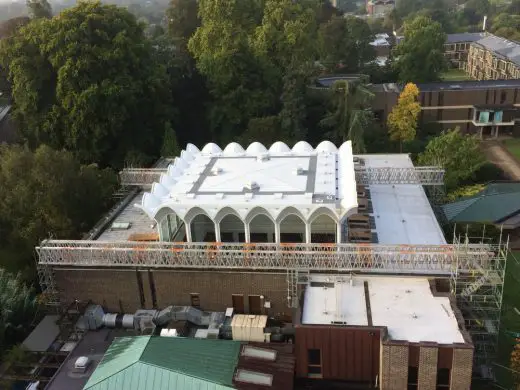
Working closely with architect Cullinan Studio, Roofing Contractors Cambridge (RCC) and the College, Sika Sarnafil created this innovative waterproofing solution to refurbish the roof, which has an extremely complex design.
“The original building was constructed in 1963 by famous Brutalist architect, Denys Lasdun,” comments Neil Smith, Area Refurbishment Manager at Sika Sarnafil. “From ground level you can see protruding ‘scalloped’ detailing on the roof. If you looked down on the roof from above, it is like a picture-frame, with the scallops forming the border around the edge of the flat roof. The challenge was to effectively waterproof both the flat roof – which itself had plenty of challenging details – and scalloped areas, while maintaining the look and integrity of the roof and the building as a whole.”
Dave Stewart from RCC continues: “Due to the unusual shape of the scallops, it wasn’t aesthetically practical to install sheet membrane on them, so many, many discussions took place to decide how best to tackle this!
“The Sikalastic product ensured these unique details would be protected without altering their shape. It’s not unusual for a project to incorporate small amounts of Sikalastic, but this is one of the first projects where the Sarnafil membrane and Sikalastic 621 have been used over large areas together.
“For us, the crucial element of this project was getting the seal right. We worked closely with Sika Sarnafil and did multiple tests to make sure the junction between the Sikalastic 621 and single ply membrane was formed using the most effective detailing. The use of Sarnametal created a strong bond between the two products, enabling them to be successfully sealed together. This was by far the most challenging part of the project, but demonstrates how well these products can work together for roofs with incredibly complex detailing.”
It was thanks to the collaborative relationship between Sika Sarnafil’s technical expert and RCC’s highly experienced fitters, that the finished roof met strict requirements of the architect and client.
Alex Abbey from Cullinan Studio wanted the works to be sympathetic to the original building. “We were keen to minimise weight on the roof and wanted to steer clear of asphalt and the like, so Sika Sarnafil’s lightweight products were ideal.
“We needed a product that would not only effectively waterproof but that would sit over the copper scallops and maintain the shape’s detail. The Sikalastic 621 proved ideal and worked in harmony with the Sarnafil membrane. As did the SikaFloor 420, which was used on the façade and underside of the scallops – a complete solution from Sika. And importantly, the completed roof was awarded a Sarnafil Plus guarantee by Sika, a must for the client, preserving the building as an architectural landmark and study area.”
The challenge was to effectively waterproof both the flat roof – which itself had plenty of challenging details – and scalloped areas:

Fitzwilliam College Building Roof image / information received 161117
Fitzwilliam College Building Design
Location: Huntingdon Road
Date built: 1959-60 (-67)
Design: Sir Denys Lasdun, Architect
Location: north west of the city centre
Key Sir Denys Lasdun buildings are the Royal National Theatre (1967-76) at the South Bank complex in London, the University of East Anglia, Norwich (1963-72) and the Royal College of Physicians, London (1960-64). Also by Denys Lasdun – Christ’s College building.
Fitzwilliam College Gatehouse & Auditorium building
Date built: 2004
Design: Allies & Morrison Architects
Fitzwilliam College Chapel building
Date built: 1990
Design: MacCormac Jamieson Architects
Fitzwilliam College buildings
Date built: 1994; 92
Design: Van Heyningen & Haward
Location: Huntingdon Road, Cambridge, UK
Cambridge Architecture
Cambridge Architecture Design – chronological list
Cambridge Architectural Walking Tours : city walks by e-architect
Fitzwilliam Museum
Location: Trumpington St
Date built: 1837-41
Design: George Basevi
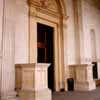
photo © Adrian Welch
Nearby is Pembroke College complete with Chapel building by Christopher Wren and in 1997 the beautiful Foundress Court by architect Eric Parry.
Bingo Hall, 1930 – Hobson St
Art Deco architecture – converted cinema opposite Christ’s College
Fitzwilliam Museum – exterior

photo © Adrian Welch
Henry Moore sculpture
Fitzwilliam College Gatehouse : Allies & Morrison Architects
Fitzwilliam College Chapel : MacCormac Jamieson Architects
Cambridge Building – Architecture Tour of the city on one page
Cambridge Architects – Alphabetical list of all featured designers
Fitzwilliam College Cambridge: Photo © Adrian Welch
Fitz is one of the constituent colleges of the University of Cambridge, England. The college traces its origins back to 1869 and the foundation of the Non-Collegiate Students Board, a venture intended to offer students from less financially privileged backgrounds a chance to study at the university.
The institution was originally based at Fitzwilliam Hall (later renamed Fitzwilliam House), opposite the Fitzwilliam Museum in central Cambridge. Having moved to its present site in the north of the city, Fitzwilliam attained collegiate status in 1966. Female undergraduates were first admitted in 1978, around the time most colleges were first admitting women.
The college is now home to around 450 undergraduates, 300 graduate students and 90 fellows.
Source: Wikipedia
Fitzwilliam College context : New Hall College Cambridge
Comments / photos for the Fitzwilliam College Architecture – University Building page welcome

